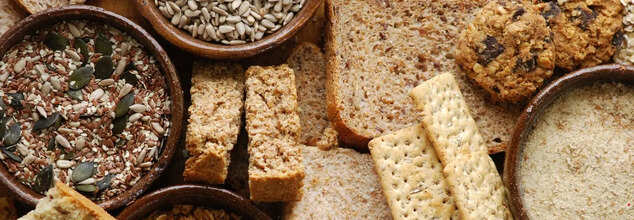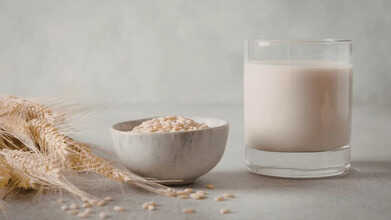- Health Conditions A-Z
- Health & Wellness
- Nutrition
- Fitness
- Health News
- Ayurveda
- Videos
- Medicine A-Z
- Parenting
Is There A Right Time To Consume Fibre?

Fibre (Credit: Canva)
Fibre, also known as roughage, is important for your overall health. A person needs fibre for digestion, weight control, to manage cholesterol and blood sugar and to strengthen bones. However, have you ever wondered if there is a right time to consume fibre and its supplements?
How Much Fibre Does One Require In A Day?The recommended daily intake of fibre is 25 grams per day for women and 38 grams per day for men. However, some experts estimate as much as 95 per cent of the population doesn’t ingest this much fibre, and may require fibre supplements due to dietary and age restrictions. On the other hand, ingesting too much fibre, while uncommon for most people, can lead to several uncomfortable digestive and health-related side effects.
Does Timing Matter?
No, Fibre can be consumed throughout the day. However, one needs to be careful while consuming fibre supplements. There is limited research which underscores that timing does matter. Many studies suggest taking fibre supplements at meal times can help your body absorb them better and may make them more effective. No matter when you consume the supplements, consistency is the key. Irregular intake of fibre supplements can trigger discomfort like bloating, gas, and changing bowel patterns.
Should You Take It With Food?
Most research suggests that taking fibre supplements with food can help improve digestion and prevent digestive discomfort. Taking fibre before a meal may help control your appetite and help you feel full. Taking it after a meal may support digestion by bulking up your stool. Some people may experience discomfort when taking a fibre supplement too close to mealtimes. Unless your healthcare provider or registered dietitian says otherwise, consider taking fibre at least 30 minutes before or after eating. You should also drink plenty of water.
What Happens When You Consume Excessive Fibre?
Consuming excess fibre or its supplements can result in bloating. Insoluble fibre found in whole grains, vegetables, and nuts, can increase gas production during digestion, causing bloating. It can also cause abdominal pain. Too much fibre can cause the digestive system to work harder than usual, leading to abdominal cramping or discomfort. This occurs as fibre moves slowly through the intestines, increasing the workload on the digestive muscles.
Flatulence (Gas) is another issue. Fibre-rich foods, especially legumes, vegetables, and grains, produce gas as they break down in the intestines. This is a normal byproduct of digestion, but excessive fibre can lead to more gas than the body can comfortably handle.
Soluble fibre, found in oats, beans, and fruits, absorbs water, which can lead to overly loose stools or diarrhoea, as excess water may remain in the intestines. On the flip side, an abrupt increase in fibre without enough water intake can cause constipation. Fibre requires water to move smoothly through the digestive tract, so dehydration or insufficient hydration can lead to harder stools.
High-fibre foods tend to be bulkier, and consuming too much can lead to temporary weight gain due to water retention and slower movement of fibre through the digestive tract. Additionally, fibre can make you feel fuller, causing temporary bloating. Excessive fibre intake can cause a blockage in the intestines, particularly in people with Crohn’s disease or other inflammatory bowel conditions. Since fibre isn’t fully broken down, it can accumulate, potentially causing an obstruction.
Fibre helps slow down the absorption of sugar, leading to more stable blood sugar levels. However, too much fibre may lower blood sugar too drastically, which is a concern for people with diabetes who may be monitoring their blood sugar levels closely.
Supplements, Gummies, Or Whole Foods? Here’s What Experts Recommend

Credits: Canva
In a world where colourful vitamin gummies line supermarket shelves and powders promise instant wellness, many people are left wondering: should I really rely on supplements, or is eating well enough? Experts say the answer isn’t as simple as choosing one over the other.
Why Natural Foods Come First
Dr. Hari Kishan Boorugu, Consultant Physician and Diabetologist at Yashoda Hospitals, Hyderabad, emphasizes that “whole, natural foods should always come first.” Fruits, vegetables, whole grains, nuts, seeds, fish, yogurt, and healthy oils are packed with vitamins, minerals, fibre, antioxidants, and other plant compounds that work together to support digestion, immunity, heart health, and gut microbiome balance. “Supplements can’t fully replicate the synergy of nutrients found in real foods,” he adds.
Supplements, including tablets, capsules, powders, and even gummies—are meant to fill specific gaps. They are particularly useful for people with diagnosed deficiencies, dietary restrictions, pregnancy-related needs, ageing-related bone health, or medical conditions that affect nutrient absorption. But Dr. Boorugu cautions that “self-prescribing or overusing supplements can lead to nutrient imbalances or even toxicity, especially with vitamins A, D, E, and K.”
The Truth About Gummies
Gummies have become popular for their taste and convenience. Yet, experts warn that they are not a substitute for a balanced diet. “Many gummies contain added sugar and inconsistent doses of nutrients,” Dr. Boorugu explains. They can support your nutrition, but only when used responsibly and under medical guidance.
Supplements As Support, Not Shortcuts
Ruchika Rajbans, Founder & CEO of Arechar Group and creator of Vitagoli, says people often ask her, “Do I really need supplements? Isn’t eating well enough?” Her answer: ideally, yes—food should cover your nutritional needs—but real life often interferes. Stress, lack of sleep, overworking, and hormonal changes can affect how well your body absorbs nutrients.
“Supplements are gap fillers, not meal replacements,” Ruchika explains. “Whether in gummies, tablets, or powders, what matters is the quality of the ingredients and whether there’s evidence backing their benefits.” She adds that wellness isn’t about chasing trends or formats; it’s about understanding your body, reading labels carefully, and making informed choices.
Experts agree that balance is key. Prioritize a varied, nutrient-rich diet, maintain a healthy lifestyle, and use supplements only when necessary, preferably with medical guidance. Real nutrition starts on your plate—not in a capsule or gummy.
What Is ‘Oatzempic’? TikTok’s New Weight-Loss Trend Explained

Credits: Canva
If you scroll through TikTok or Instagram these days, chances are you have come across videos of people blending oats with water or juice and calling the drink “oatzempic”.
The term is clearly inspired by Ozempic, a prescription drug mainly used to treat type 2 diabetes and known for reducing appetite. Clips featuring the oat-based drink often promise quick weight loss, long-lasting fullness, and a “natural substitute” for medication. But does oatzempic have any scientific backing? In short, no. Here’s a closer look at why.
What Is Oatzempic?
There is no fixed formula for oatzempic. Most videos show people blending one or two tablespoons of rolled oats with a glass of water. Some add lemon or lime juice, cinnamon, or soak the oats beforehand. Oats are high in beta-glucan, a form of soluble fibre that turns gel-like when mixed with liquid. The idea is that drinking this mixture will help you feel full and curb hunger.
Many TikTok creators suggest replacing breakfast with oatzempic. Others recommend drinking it mid-afternoon to avoid overeating later.
Oatzempic: What Happens When You Drink It?
As per The Independent, many people online say they feel fuller after drinking oatzempic, which makes sense. Oats contain beta-glucan, a soluble fibre that forms a thick gel in the digestive tract. This slows digestion and can increase feelings of fullness. Strong evidence shows that diets rich in viscous soluble fibre, such as that found in oats, can modestly improve appetite control, blunt blood sugar spikes after meals, and support healthier cholesterol levels.
That said, oats are not unique in this respect. Foods like apples, citrus fruits, flaxseeds, barley, psyllium husk, and legumes such as beans and lentils also contain soluble fibres that behave in a similar way in the gut, promoting fullness and overall health. So yes, oats can help you feel satisfied. But feeling full alone does not equal lasting or meaningful weight loss.
Sustainable weight management depends on balanced eating and regular physical activity, not just appetite suppression.
Has Oatzempic Actually Been Studied For Weight Loss?
No. There are no clinical studies examining the “oatzempic drink” for weight loss, appetite regulation, or long-term health effects. There is no agreed recipe, no standard quantity, and no research following its use over time.
If someone loses weight while drinking it, it is difficult to know whether that change is due to oatzempic itself, reduced calorie intake overall, or other lifestyle adjustments happening at the same time.
Oatzempic: Are There Downsides To Consider?
For most people, drinking small amounts of oatzempic is unlikely to be harmful. Still, there are a few points worth keeping in mind:
- It is not a complete meal. Oatzempic lacks adequate protein, healthy fats, and several essential nutrients. Regularly replacing meals with it could lead to nutrient deficiencies or under-eating
- Increasing fibre too quickly can cause discomfort. People who are not used to high-fibre diets may experience bloating or digestive issues, particularly if they are not drinking enough fluids
- The name itself can be misleading. Calling it “oatzempic” encourages comparisons with a prescription drug, which may wrongly suggest it has similar effects
- It may delay proper care. Relying on a viral drink instead of seeking evidence-based nutrition or medical advice could stop people from getting the support they actually need.
Are All Ultra-Processed Foods Bad For You? Experts Say Some Are Better Than Others

Credits: Canva
Frozen pizza, ready-made meals, instant noodles, and many packaged breads are often cited as examples of what are known as ultra-processed foods. These are products made with long ingredient lists, chemical additives, and very little in the way of whole or natural foods.
In recent years, ultra-processed foods, often shortened to UPFs, have drawn growing attention. Data from the Centers for Disease Control and Prevention (CDC) shows that between 2021 and 2023, about 53 percent of the average adult’s daily calorie intake came from ultra-processed foods. Among children aged 18 and under, that number was even higher at 61.9 percent.
That said, experts stress that not all ultra-processed foods are the same. Some options are clearly better than others. By taking a closer look at ingredient lists and watching for additives, preservatives, fillers, and artificial components, it is possible to either avoid these foods altogether or choose versions that contain fewer questionable ingredients.
It also helps to understand that food processing exists on a spectrum. The aim is to choose the least processed version available. In some cases, that means foods with just one or two basic ingredients. In others, it may still mean an ultra-processed product, but one with less salt, sugar, artificial additives, and unnecessary extras than the standard option.
The Washington Post got in touch with health experts and below are common red flags to look for, along with healthier choices in each category.
Ultra-Processed Foods: What To Avoid And What To Pick
1. Sliced bread
Look for breads labelled “whole grain” or “100 percent whole grain,” advises Kelly Springer, a registered dietitian and founder of Kelly’s Choice, a nutrition company based in Skaneateles, New York.
Whole grains contain three key parts: bran, germ, and endosperm. Many ultra-processed breads use flour made only from the endosperm, which strips away much of the fibre and nutrients found in the bran and germ.
Red flags:
White flour as the first ingredient: This suggests the bread is made from refined grains with most nutrients removed.
Additives such as azodicarbonamide, calcium propionate, and potassium sorbate: A long list of unfamiliar additives is a warning sign. Compare that to simpler ingredients like whole wheat, salt, yeast, seeds, and vinegar.
Emulsifiers, preservatives, and dough conditioners: These are used to soften bread, extend shelf life, and improve appearance. Watch for ingredients like mono- and di-glycerides, sodium stearoyl lactylate, and butylated hydroxyanisole (BHA). “In general, fewer ingredients are better, especially if you can pronounce them,” said Beth Czerwony, a registered dietitian with the Cleveland Clinic’s Center for Human Nutrition.
Healthier options:
- Dave’s Killer Bread: Made with whole grains, seeds, and organic ingredients, this bread is high in protein and free from artificial additives. “This is the bread we buy at home for our kids,” Springer said.
- Food for Life Ezekiel Bread: Produced from organic, whole grains and legumes, this bread uses sprouted grains, which are soaked until they begin to germinate. Springer said this process makes the bread easier to digest and suitable for some people with mild gluten sensitivity.
- Beckmann’s Whole Wheat Sourdough Bread: Contains a short list of ingredients including whole wheat flour, water, sea salt, barley malt, and vitamin C.
- Alvarado St. Bakery: Uses organic, sprouted whole grains such as wheat berries, oats, barley, and millet in its breads.
2. Chicken nuggets
Chicken nuggets often come with long ingredient lists because they include breading, flour, and common seasonings like garlic, onion powder, paprika, and salt. Still, unfamiliar ingredients are a sign the product may be heavily processed.
Red flags:
- “White chicken meat”: This term can mean a mix of chicken parts beyond breast meat, including ground tissue and connective material. Look for nuggets that list “chicken breast” or “whole breast meat.”
- Fillers: Ingredients like wheat gluten and textured soy protein are sometimes added so manufacturers can use less meat.
- Chemical additives: Preservatives, emulsifiers, stabilisers, and fast-acting leavening agents are common. These may include propylene glycol, pyrophosphate, calcium phosphate, and sodium phosphate.
- High sodium: Foods with 20 percent or more of the daily sodium value per serving are considered high in salt.
Healthier options:
- Bell & Evans Chicken Breast Nuggets: Made with chicken breast and a limited number of simple seasonings.
- Tyson Naturals Gluten Free Breaded Chicken Breast Nuggets: These use ingredients like yellow corn flour and brown rice flour and contain no artificial additives.
- Kidfresh White Meat Chicken Nuggets: Include pureed vegetables such as cauliflower and onions and are lower in sodium than many alternatives.
- Just Bare Lightly Breaded Chicken Breast Bites: Made with basic ingredients including spices, egg whites, salt, and breading.
3. Peanut butter
Many popular peanut butter brands contain added ingredients to improve texture and shelf life, including sugar, hydrogenated oils, and emulsifiers. These additions can push peanut butter into ultra-processed territory.
Red flags:
Palm oil or hydrogenated vegetable oils: Oils like cottonseed, soybean, or rapeseed are often added to prevent separation. Products with these oils may be labelled “no stir” or called “peanut butter spread.”
- Mono- and di-glycerides: These emulsifiers help keep oil from separating and extend shelf life.
- Added sugars: Some brands include a teaspoon of sugar or more per serving.
Healthier options:
These products contain only peanuts, or peanuts and salt:
- Smucker’s All Natural Peanut Butter
- Trader Joe’s Creamy Peanut Butter Unsalted
- Santa Cruz Organic Creamy Dark Roasted Peanut Butter
- Target’s Good & Gather Organic Stir Peanut Butter
- Kirkland Signature Organic Peanut Butter
4. Greek yogurt
Greek yogurt is highly nutritious and rich in protein, minerals, and probiotics that support gut health.
Ideally, yogurt should contain just milk and live cultures, with cream included in some cases. Any sweetness or toppings can be added at home. Stephen Devries, an adjunct associate professor at Harvard T.H. Chan School of Public Health, notes that even added honey at home is usually less than what’s found in flavoured yogurts.
Red flags:
Added sugars: Ingredients like cane sugar, corn syrup, brown sugar, honey, and fruit juice concentrates can turn yogurt into a dessert.
- Artificial sweeteners: Products marketed as “no added sugar” may contain sucralose, stevia, Ace-K, or aspartame. Devries warns these can affect gut and metabolic health.
- Thickeners and stabilisers: Gelatin, corn starch, guar gum, and tricalcium citrate are often added for texture.
- Preservatives: Sodium benzoate and potassium sorbate are commonly used to extend shelf life.
Healthier options:
These plain yogurts contain no additives. Fat content varies by milk choice and does not affect processing level.
- Fage Total Plain Greek Yogurt
- Chobani Greek Yogurt Plain
- Target’s Good & Gather Greek Plain Yogurt
- Walmart’s Great Value Greek Plain Yogurt
- Stonyfield Organic Plain Greek Yogurt
5. Cold cuts
Cold cuts such as turkey, ham, and salami are staples in many lunches, but many are heavily processed.
Freshly sliced meat from the deli counter usually has the shortest ingredient list. Springer suggests asking deli staff which option contains the fewest additives.
If possible, choose sliced turkey, chicken, or roast beef. These are generally less processed and lower in sodium than meats like ham, salami, and bologna, which are often made from mechanically separated meat that is reshaped and sliced.
Red flags:
- Fillers and binders: Ingredients such as carrageenan, cellulose, maltodextrin, and corn syrup solids are used to improve texture and shelf life.
- Sodium nitrite or potassium nitrate: These preservatives are linked to cancer risk. Look for low-sodium options without added nitrates or nitrites.
Healthier options:
- Wegmans Just Turkey Turkey Breast: Contains only turkey breast.
- Applegate sliced turkey, chicken, and roast beef: Made with simple seasonings like salt, pepper, and rosemary extract, with no artificial ingredients or added nitrates.
- True Story Oven Roasted Turkey Breasts: Includes organic turkey, water, salt, and vinegar and is free from nitrates and nitrites.
© 2024 Bennett, Coleman & Company Limited

